Related Research Articles
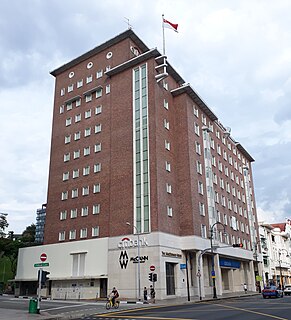
The MacDonald House bombing occurred on 10 March 1965, at the Hong Kong and Shanghai Bank building along Orchard Road of Singapore, a few months before Singapore gained independence from Malaysia. The nitroglycerin bomb was planted by Indonesian saboteurs during the period of Indonesia–Malaysia confrontation. The explosion killed three people and injured at least 33 others.
Kiras Bangun, also known as Garamata is a national hero of Indonesia.

Thomas Matulessy, also known as Kapitan Pattimura or simply Pattimura, was an Ambonese soldier and National Hero of Indonesia from Maluku.

Lieutenant General R. Soeprapto was the second deputy commander of the Indonesian Army, and was kidnapped from his home in Jakarta by members of the 30 September Movement in the early hours of 1 October. He was later killed at Lubang Buaya.

Siswondo Parman or more popularly known such as in streets name as S. Parman, was a soldier in the Indonesian Army, and was kidnapped from his home in Jakarta by members of the 30 September Movement in the early hours of October 1. He was later killed at Lubang Buaya.

Mas Tirtodarmo Haryono was a general officer in the Indonesian Army who was killed during an attempt to kidnap him from his home by members of the 30 September Movement in the early hours of 1 October 1965.

Air Vice-Marshal Abdul Halim Perdanakusuma, better known as Halim Perdanakusuma, was an Indonesian airman and National Hero of Indonesia.
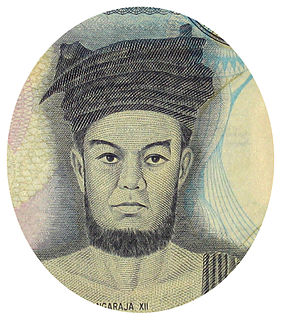
Patuan Besar Ompu Pulo Batu, better known as Si Singamangaraja XII, was the last priest-king of the Batak peoples of north Sumatra. In the course of fighting a lengthy guerrilla war against the Dutch colonisation of Sumatra from 1878 onwards, he was killed in a skirmish with Dutch troops in 1907. He was declared a National Hero of Indonesia in 1961 for his resistance to Dutch colonialism.

Dr. Sahardjo LL.B., was Minister of Justice of Indonesia during three cabinets, the First, Second, and Third Working Cabinets.
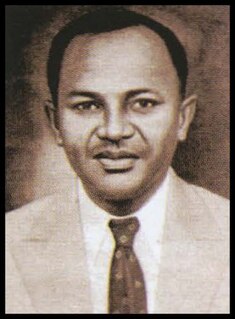
Teungku Nyak Arif was an Acehnese nationalist and National Hero of Indonesia. He has been given the nickname Rencong of Aceh, after the traditional Acehnese weapon, for his bravery.

Siti Walidah, better known as Nyai Ahmad Dahlan, was a female emancipation figure, wife of Muhammadiyah founder Ahmad Dahlan, and National Heroine of Indonesia.

Prince Antasari, also known by his Indonesian name Pangeran Antasari, was a sultan of Banjar and is a National Hero of Indonesia.
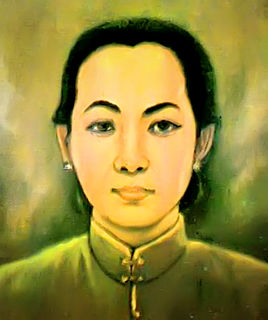
Raden Ajeng Kustiyah Wulaningish Retno Edhi (1752–1838), better known as Nyi Ageng Serang, is a National Hero of Indonesia.
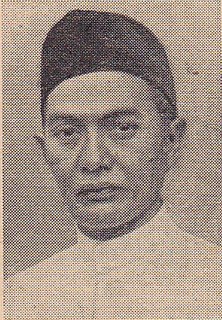
Kyai Hajji Mas Mansoer was an Indonesian Islamic scholar and a national hero.

Air Commodore Iswahyudi was an Indonesian airman and National Hero. On 14 December 1947, the plane he was flying with Halim Perdanakusuma crashed off the coast of Tanjung Hantu Hill, Perak, Malayan Union. Halim's body was later found, but Iswahyudi's was never recovered.
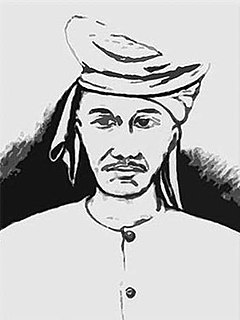
The Nuku Rebellion was an anti-colonial movement that engulfed large parts of Maluku Islands and Western New Guinea between 1780 and 1810. It was initiated by the prince and later sultan of Tidore. Nuku Muhammad Amiruddin, also known as Prince Nuku or Sultan Nuku. The movement united several ethnic groups of eastern Indonesia in the struggle against the Dutch and was temporarily successful, helped by an alliance with the English East India Company. After the demise of Nuku it was however defeated, and Maluku was restored under European rule. In modern time, Nuku was officially appointed a National Hero of Indonesia.
National Hero of Indonesia is the highest-level title awarded in Indonesia. It is posthumously given by the Government of Indonesia for actions which are deemed to be heroic, defined as "actual deeds which can be remembered and exemplified for all time by other citizens" or "extraordinary service furthering the interests of the state and people". The Ministry of Social Affairs gives seven criteria which an individual must fulfill, as follows:
- Have been an Indonesian citizen who is deceased and, during his lifetime, led an armed struggle or produced a concept or product useful to the state;
- Have continued the struggle throughout his life and performed above and beyond the call of duty;
- Have had a wide-reaching impact through his actions;
- Have shown a high degree of nationalism;
- Have been of good moral standing and respectable character;
- Never surrendered to his enemies; and
- Never committed an act which taints his or her legacy.

Admiral Raden Eddy Martadinata was an Indonesian Navy admiral and diplomat. He was conferred the title of "National Hero of Indonesia" posthumously in 1966. He is recognised as one of the founders of the Indonesian Navy.

Izaak Huru Doko is a National Hero of Indonesia. The title was granted on 3 November 2006.
Harun Thohir or Harun Bin Said (1947-1968) was an Indonesian soldier born in Bawean Island, East Java, on 4 April 1947 to Mahdar and Aswiyani., while another source stated that he was born on 14 April 1947.
References
- 1 2 3 Sudarmanto 2007 , p. 162
- 1 2 Komandoko 2006 , p. 480
- ↑ Ajisaka 2008 , p. 215
- ↑ Ajisaka 2008 , p. 216
- ↑ Sudarmanto 2007 , p. 164
- ↑ "4 Fakta Harun Tahir Pahlawan Asal Bawean Yang Bikin Bangga". Berita Bawean (in Indonesian). Retrieved 7 June 2020.
- ↑ "Liontin Garuda, Misteri Peninggalan Harun yang tak Terungkap". SINDOnews.com (in Indonesian). Retrieved 7 June 2020.
- ↑ "Singapore: Naming Indonesian warship after marines would reopen old wounds". 7 February 2014.